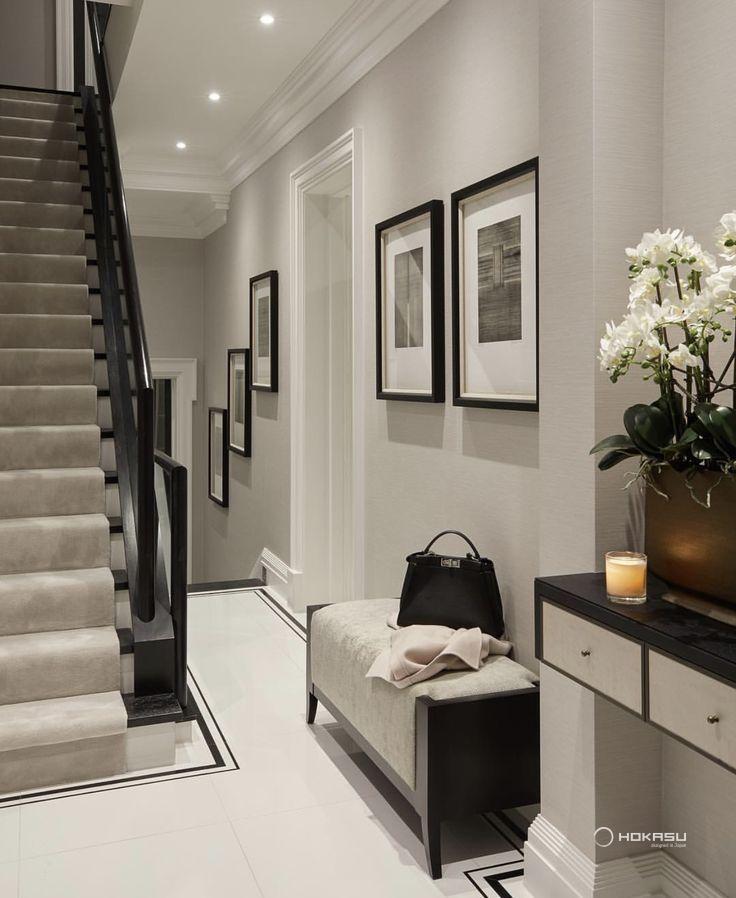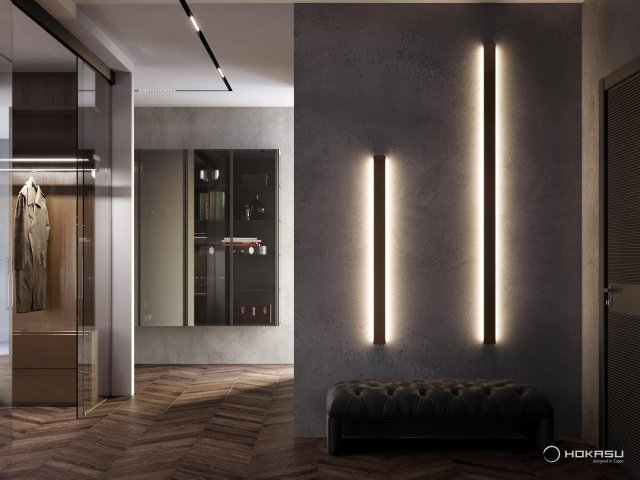Cookies are used for optimal website experience.

Hallway lighting
Our Projects
Most modern hallways are windowless rooms, which means that natural light does not penetrate here in any way. You can compensate for the lack of lighting with the help of artificial light sources, and it is important to organize them so that the hallway does not seem dark and gloomy, but it is not too bright either. What features of the hallway lighting should be taken into account, what light sources should be there, and how can they be used to divert attention from the shortcomings of the room? The answers to these questions are in the article.
What are the basic rules to follow?
When choosing light sources and a place for them, you should be guided by some rules that will help bring comfort and coziness to the room. So, the main requirements for hallway lighting are as follows:
- the light should not be dim, as it will be impossible to find the necessary object, consider your reflection in the mirror before going out;
- the other extreme, too bright light, is also inappropriate, as it will emphasize all the shortcomings of repair and decoration, and when entering from a dark entrance it will hurt your eyes;
- the optimal level of lighting in the hallway is the same as in neighboring rooms, so that the whole apartment becomes a single harmonious space. In order for the lighting to be approximately the same both during the day and in the evening, several light sources are provided in the hallway;
- The best option is diffused light, which is achieved by using frosted shades for sconces and chandeliers, as well as by directing the beams up so that they reflect from the light finish of the ceiling and create uniform sufficient lighting;
- Dangling shades in hallways that are not too high and sconces located too low - the risk that they can be caught by the hand or parts of clothing when changing clothes.
Zoning with light
Even in the smallest hallway, it would be nice to highlight several different light sources. This will make it possible to turn on only those lamps that are really needed in each specific case and create the right lighting every time. If the hallway is of normal size, then it does not hurt to provide switches in different places so as not to go through the darkness in search of it, but to be able to turn on the light from the living room, for example.
It does not interfere with highlighting light accents in the hallway. So, the most illuminated place can be the entrance area, where households and guests get dressed, put on shoes, etc. The accent can also be placed near the doors to the living room, and the light will, as it were, invite you to enter. The rest of the doors leading to the bedrooms and other rooms do not need to be highlighted.
It would be nice to highlight the following types of lighting in the hallway:
- general, which is included at the entrance;
- local, which is necessary to highlight important areas in the hallway, incl. mirror, cabinet, etc.;
- decorative, it will decorate the room, emphasize some interesting elements and even make the hallway visually more spacious.
Organization of general light
The function of the main light is extremely clear and consists in illuminating the space for the one who has just entered here. Often only such lighting is dispensed with, which makes sense in very small hallways. General light can be arranged in one of the following ways:
- linear luminaires is a great option, they can cope with full lighting of the entire hallway area. Thanks to the ability to create a transition from the ceiling to the wall with a continuous line of light, we do not need additional sources.
- spotlights - a great option, but will require the organization of tension or suspension structures. Thanks to numerous light beams, uniform and sufficient illumination is achieved, but often such lamps are combined with a diffuser ceiling in the center of the ceiling;
- track lights can independently cope with the full lighting of the hallway. Their peculiarity lies in the fact that several lamps can be located on one busbar. Their location can be changed, reaching the required angle of light and illumination of all required areas;
- wall sconces usually complement ceiling lights, but in some cases can become a standalone light source. It is better to place the sconces at a height of 2 meters, which will allow the rays to scatter, evenly distribute, not be in the eye, and the likelihood of damage to the lamp will be lower.
Local lighting
Local lighting will greatly simplify the search for the necessary items and help you better see yourself in the mirror. Usually, local light is arranged in the area of the cabinet, mirrors, shelves with small things, etc. If we are talking about a closet, then the lamps can be built into the walls, the visor and the body, and the system can be configured so that the light turns on automatically when the door is opened.
The mirror also needs additional lighting, because it is important for each of us to know how it looks before going outside. You can place the lamps on the sides or on top of the mirror. In preference - lamps that gently scatter light.
Decorative lighting
This lighting is not mandatory, but its presence can transform the hallway and correctly place accents in it. Often for this purpose, LED strip is used, which is laid along the perimeter of the floor or ceiling, visually expanding the space and blurring boundaries. Moreover, floor lighting will be useful at night, when you don’t want to turn on the main light, and the LED strip will create soft, but sufficient lighting to see everything. In addition, if there are any irregularities in the hallway, such as steps, podiums, etc., then floor lighting becomes even a necessary thing.
Here's how we create awesome lighting
Application
Please leave your application, and we will contact you to discuss all the details of your project.
It's important for us to consider your preferences.
Project
We will develop a unique concept for a comfortable lighting environment.
We will consider various lighting scenarios and convenient control methods.
Approval
We will address all comments and prepare the final proposal.
We will conduct lighting calculations and prepare all necessary documentation for the builders.
Production
We will manufacture cool luminaires with individual characteristics for you.
Carefully packed, we will deliver all equipment to your site.
Author's Supervision
A specialist from our company will consult your builders.
We will ensure that everything corresponds to the project.
From this moment on, you are in the reliable hands of our service team.
